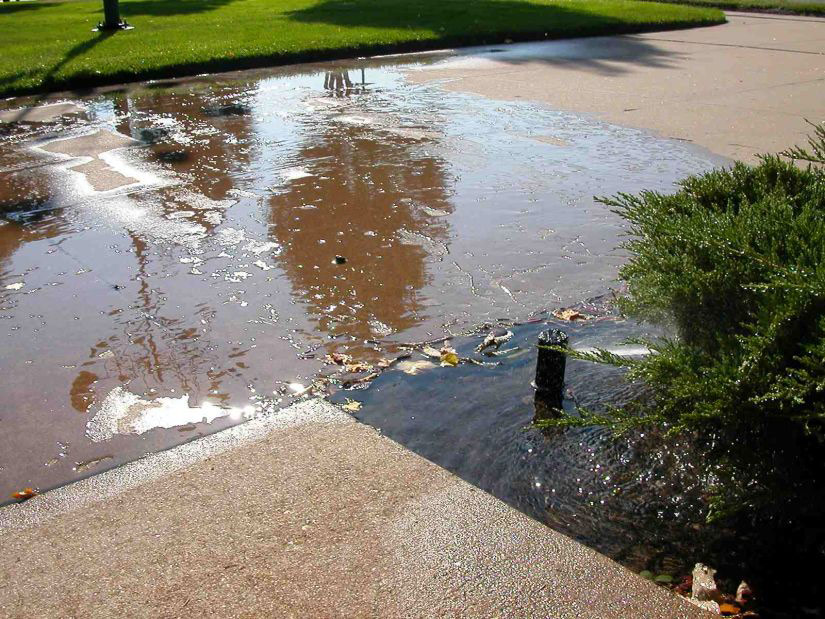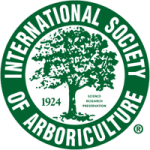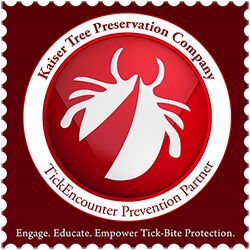Quite often, a tree will appear stressed (off color leaves, dieback), prompting a homeowner to contact an arborist. It is very easy for a homeowner (and an arborist) to assume that the problem with the tree is associated with an insect or a disease, and can be treated with some type “tree medicine.” All too often, what’s happening below the surface is ignored.
Here are some examples of soil/root problems, and other problems commonly caused by humans.
Soil Compaction
Problem:
 Trees positioned in high traffic areas (lawns, near houses and buildings, walkways) often suffer from soils which have been severely compacted over time. Foot traffic, lawnmowers, and sometimes heavy equipment make the soils too hard for water and air to penetrate, making it hard for the tree to get the nutrients it needs to function
Trees positioned in high traffic areas (lawns, near houses and buildings, walkways) often suffer from soils which have been severely compacted over time. Foot traffic, lawnmowers, and sometimes heavy equipment make the soils too hard for water and air to penetrate, making it hard for the tree to get the nutrients it needs to function
Solution:
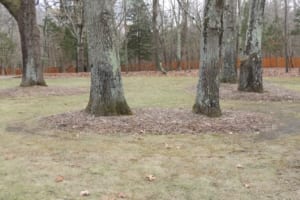 Grass within a certain radius of the tree trunk (typically 5-10′) is removed. The radius is covered in a 4-6″ thick layer of wood chips. This eliminates further compaction, and as the chips break down, beneficial soil organisms will thrive in the area, softening and enriching the soil over time. All trees should have some sort of wood chip or mulch ring around them, if possible.
Grass within a certain radius of the tree trunk (typically 5-10′) is removed. The radius is covered in a 4-6″ thick layer of wood chips. This eliminates further compaction, and as the chips break down, beneficial soil organisms will thrive in the area, softening and enriching the soil over time. All trees should have some sort of wood chip or mulch ring around them, if possible.
Girdling Root(s)
Problem:
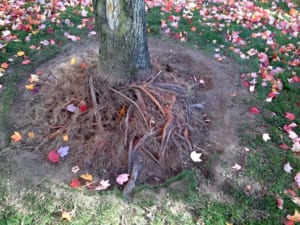 This photo was taken after a tall mound of mulch (volcano mulching) had been removed from the tree’s root area. The malformed roots (girdling roots) shown in this picture will begin to wrap around the tree trunk and slowly constrict the tree. This will cause dieback and eventually kill the tree.
This photo was taken after a tall mound of mulch (volcano mulching) had been removed from the tree’s root area. The malformed roots (girdling roots) shown in this picture will begin to wrap around the tree trunk and slowly constrict the tree. This will cause dieback and eventually kill the tree.
Solution:
As shown in this photo, the first step is to remove all of the mulch and soil around the root system, and expose the girdling roots. Next, the arborist performs the appropriate root pruning. This allows the healthy roots to continue growing, and gets rid of the ones which are currently, or soon to be hurting the tree. Lastly, the root system is covered back up with some loose soil and a light layer of mulch or wood chips.
Volcano Mulching
Problem:
 Landscapers do their spring cleanups, make the yard nice and tidy, and then go around re-mulching the beds. Little by little, the mulch is piled higher and higher up against the tree trunks. After several years, the mulch is mounded so high, it takes on the look of a volcano. Sound familiar? This is very harmful to trees. It causes them to form layers of competing roots, and girdling roots.
Landscapers do their spring cleanups, make the yard nice and tidy, and then go around re-mulching the beds. Little by little, the mulch is piled higher and higher up against the tree trunks. After several years, the mulch is mounded so high, it takes on the look of a volcano. Sound familiar? This is very harmful to trees. It causes them to form layers of competing roots, and girdling roots.
Solution:
Don’t over mulch! Mulch only needs to be added in thin layers, and often times, properties only need to be mulched every other year. Here’s a tip -In alternating years, instead of re-mulching, use a metal rake to turn the existing mulch over. This gives the beds a fresh look, and helps the existing mulch fully break down, instead of just layering new mulch over the existing mulch.
Over watering with Lawn Irrigation
Problem:
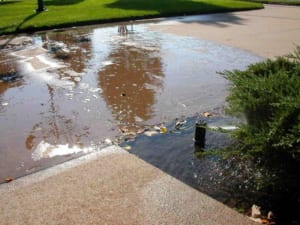 Lawn irrigation sprinklers are designed to water the lawn, not shrubs. They are usually set on once a day intervals. This may be fine for the grass, but is too much for most plants. Overwatering causes the nutrients to leach out of the soil, and the excessive moisture often leads to root decay. Also, if the lawn sprinklers are hitting the shrub itself, this often leads to leaf diseases.
Lawn irrigation sprinklers are designed to water the lawn, not shrubs. They are usually set on once a day intervals. This may be fine for the grass, but is too much for most plants. Overwatering causes the nutrients to leach out of the soil, and the excessive moisture often leads to root decay. Also, if the lawn sprinklers are hitting the shrub itself, this often leads to leaf diseases.
Solution:
Adjust sprinkler heads so they don’t spray in the beds, and so they don’t hit the foliage of trees or shrubs.
Weed Whacker and Lawn Mower Damage
Problem:
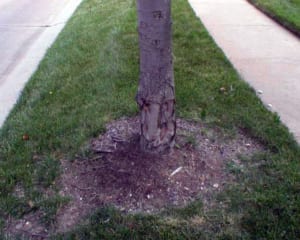 Trees growing directly out of a lawn are prone to damage from a weed whacker or a lawnmower. In an effort to do a thorough job at maintaining the grass, over-zealous landscapers quite often do more harm than good, as they chase after every last blade of grass. The bark of trees and shrubs gets nicked by the trimming tool, and opens the tree up to rot and insect damage.
Trees growing directly out of a lawn are prone to damage from a weed whacker or a lawnmower. In an effort to do a thorough job at maintaining the grass, over-zealous landscapers quite often do more harm than good, as they chase after every last blade of grass. The bark of trees and shrubs gets nicked by the trimming tool, and opens the tree up to rot and insect damage.
Solution:
All trees growing in a lawn should have a 2-3″ deep mulch or wood chip ring surrounding them. The ring can be as small as 2′ out from the trunk, or it can reach out as far as the drip line of the tree. Either way, this eliminates the need for the person maintaining the grass to get anywhere near the tree trunk with their power tools. This wood chip or mulch ring also keeps soil compaction to a minimum, and creates a more fertile soil for the tree or shrub to thrive in.
